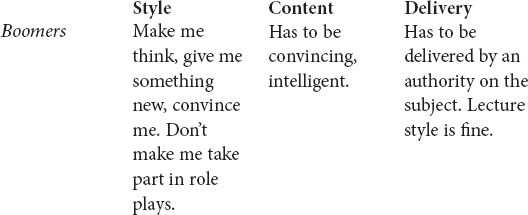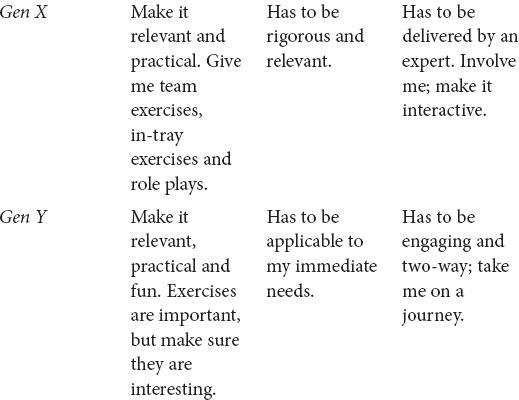CHAPTER 6
How to develop Gen Y
(or how to help them
learn)
The essentials – what you need to
know to understand how Gen Y
learns
What has shaped how they learn?
Technology (of course) has been the big shaper of how Gen Y learns. There are other factors at play too, like the so-called “helicopter” parenting that they have experienced. Have a look into their world – it will shed light on why they are as they are:
• Instant access to information, facts and knowledge via Google and websites such as Wikipedia.
• Previous generations used to have to go to the library or ask someone; Gen Y just Google.
• Learning and reciting facts by rote is not important in a world where knowledge is available at our fingertips wherever we are.
• They use different places for different types of learning. They will study quietly and alone in libraries, and use that quiet reflection time. They will also huddle around laptops with other students and learn collaboratively.
• The teacher is not the “expert”, but a resource to help them learn.
• Learning together is not cheating.
• They are used to getting frequent feedback and attention from parents.
• Schools sometimes struggle to keep up with Gen Y’s learning needs, because they are used to a world where they can customize what they want (such as iTunes, or their trainers) and get information when and where they need it.
• They grew up in a world of the internet and bite-sized information that comes at them as quickly as they can click a mouse. So more complex concepts or problems that cannot be instantly understood can be a challenge to Gen Y’s patience.
• They are used to multi-tasking – there is a clear upside to that. The downside, though, is that they can sometimes have a short attention span. However, they have long attention spans if they are interested in what they are doing. It is all about relevance – if they feel something is worthwhile, they will stick at it. If not, they will switch off or start multi-tasking. One of my Gen Y mentees told me that when he is on training courses that he loses interest in, he starts making notes on other things or using his BlackBerry under the table.
• They grew up in a world where there is less reliance on experts who have a monopoly on knowledge (and therefore power). Doctors, teachers, lawyers – they can all be challenged much more easily now that lots of information is available on the web.
Differences in learning styles and
preferences between the different
generations
Good learning theory applies to development of all generations, of course, but there are some specific differences in each generation’s preferences. These are worth knowing about, as they will influence the design of learning and training programmes. For example, if Boomers and Gen X don’t believe that their trainer is an expert with relevant credentials and background, they will not have confidence in him or her. For Gen Y, the information and insight they are gaining from the trainer is more important than whether that person is a recognized “expert” or not.
 Rookie Buster
Rookie Buster
For Gen Y, the information and insight they are gaining from the trainer is more important than whether that person is a recognized “expert” or not.
Below are the key differences between the generations. These differences make it a challenge to design learning events that are suitable for all generations, but it is still possible to achieve a blend of content and style to meet all their needs. And of course it will be useful to point out each group’s differences, as it will enhance everyone’s understanding and appreciation of their colleagues.


What is Gen Y’s preferred way of
learning?
Understanding the context within which Gen Y grew up helps you to understand how they learn. It also helps you to understand why their learning preferences are so different from those of their older colleagues. Here, in a nutshell, are the important ingredients of learning the Gen Y way.

On-demand/instant responses
• They are used to Google and to being able to access information wherever they are, whenever they want to.
• They will seek the information they need from inside or outside their organization. For them, inside/outside are artificial barriers – they will go to where they think they are most likely to get the information.
• Technology has accustomed them to getting answers quickly – they can search YouTube and find a two-minute video that will tell them what they need to know, when they need to know it.
Constant feedback
• They are used to parents who are closely involved with their day-to-day activities and give them ongoing feedback as to how they are doing.
• Their use of technology has conditioned them into expecting not to have to wait for a response.
• Learning is a constant state, and so they look for the opportunity to learn in any situation – and the more feedback they can get, the better, because that’s central to their ability to learn.
Learning with others
• They are used to playing computer games with people all around the world – some they know, some they don’t. And they are used to helping one another with their homework, live and online. One teacher learned that some of her class were collaborating online to do their homework. Instead of making them wait until the next day at school to help them with anything they were stuck on, she got online herself so that she could be immediately available when they needed her.
• Doing homework together would have been tantamount to cheating for some older people. But to Gen Y it is not cheating, it is simply working together. The dominant school system of testing people mainly as individuals has not kept pace with the times.
Fast pace
• Again, because of technology, Gen Y is used to finding and consuming information very quickly. They use the internet and can “click-on” and “click-off” websites fast.
• They have a low tolerance to training sessions in which they are “talked at” for too long or subjected to too much PowerPoint.
The right medium
• It is a fallacy that Gen Y’s preferred medium for learning is online. Sure, they are happy to learn from the web and from others via internet technology, but they are also keen to learn face-to-face from people.
• The main priority for Gen Y is that they are learning, not how they are learning. They will use the most appropriate method at the time.
Style
• Ideally, learning should be fun and entertaining. They have a low boredom threshold if they think something is not to relevant to them.
• They like to have a mix of auditory, visual and kinaesthetic aids to learning. They are after all used to multi-sensory computer games, including kinaesthetic ones (popularized by the Wii).
The environment
• It is important to remember that for Gen Y, learning is not associated with a place: learning is something they can do wherever they are.
• However, if you are organizing a specific learning event or training course, it is very important to pay attention to the physical environment. An inspiring physical environment helps all generations to learn. But while Gen X and Boomers are used to soulless training rooms, Gen Y aren’t: they expect something uplifting, somewhere they want to be, somewhere that makes them feel good and so is conducive to learning.

Learning from many situations
• Gen Y are very keen to learn, and they look for learning in many situations. Their older colleagues tend to think of learning as an event – a training course or mentoring conversation, perhaps – whereas Gen Y see learning potential in everything.
• Mentors can help Gen Ys to learn. They have so much information and data at their fingertips that mentors can also serve a useful purpose in helping them to sift out the useful information and discriminate between good-quality and bad-quality information.
Relevance
• In this information-rich world, Gen Y are used to quickly sifting to find what is relevant to them. They are used to being delivered relevant information at the press of a button. They are not interested in attending training courses or following e-learning packages that contain information that is not relevant (or that they don’t think is relevant).
• They are used to being able to search for exactly what they want on websites such as YouTube – and to finding the information that they need when they need it.
• To keep their attention and keep them engaged, you need to make sure they understand the relevance of what they are learning.
Facilitators
• Old-style trainers just don’t cut it with Gen Y. By “old-style”, I mean the “chalk and talk” type – the ones who are there as experts to deliver knowledge. There is nothing wrong with experts, but they need to engage their students in a dialogue – as all the best educators have always done.
• Make sure your facilitators understand generational differences in learning styles, so that they can appeal to all generations in their classes.
• When hiring facilitators, ask them what they see their job as – you are looking for learning guides, not teachers.
Gen Y will always find ways to learn, whether you help them or not. It’s just the way they are. A powerful way of making sure they learn as much as possible and remain engaged is to have them work with a skilled mentor. This doesn’t have to be time consuming, but it is invaluable for them to have someone whom they can see or call regularly, for short bursts, to process what they are experiencing and learning.
 Rookie Buster
Rookie Buster
Gen Y will always find ways to learn, whether you help them or not. It’s just the way they are.
Given all this, it is easy to see why Gen Ys might be disillusioned with the development currently on offer in many organizations – which typically doesn’t match their preferences. Most organizations offer a variety of training programmes and learning experiences (such as coaching and mentoring), but they don’t necessarily treat learning as an ongoing process, nor do they think very much about what Gen Y need to learn and how best they learn.
Here are some simple ways to develop your Gen Ys and bring out the best in them.
What Gen Ys need to learn
Gen Ys of course need to learn what all young people have needed to learn when they enter the workplace – how the organization works, what it does, what its purpose is, and so on. But there are also other issues that Gen Y are finding they need to learn about at work. Their lack of understanding of these issues can cause inter-generational conflict at work, and this conflict is more pronounced now than it has been with other generations because of Gen Y’s different values and attitudes (which we have already explored in previous chapters).
Here is what you may need to help Gen Y to understand:
• The other generations’ differences, and why they are different.
• How to influence the other generations effectively.
• How to navigate organizational politics.
Gen Y need to understand that the other generations are different from them. They have different values and attitudes when it comes to work. At times they may feel that the other generations are being too rigid or controlling. If they understand why they are as they are, and what has shaped their behaviour, they will be able to influence them much more effectively, and inter-generational conflict will reduce.
Eight easy ways to develop Gen Y
(and the other generations will
appreciate them too)
1. Get the induction right – you would be surprised how many companies hand over a folder to new recruits, parade a number of senior managers in front of them to spout company messages, and talk “at” them about the company. First of all, they may well want to know things that are different from what you want to tell them. You have to offer more than just a question and answer session. Facilitate a dialogue, allow them to contact existing employees before they start their job, and allow them a chat facility to help get their questions answered in the first few weeks of employment.
2. Make sure they have a good mentor who can help them to learn. Even if this is the only development support you give them, provided they have a committed and well-trained mentor, it will have a powerful effect.
3. Keep any training programmes focused and short and make sure they are light on “input” and heavy on “discovery”.
4. Use technology where possible and appropriate so that they can access the learning when they need it. For example, short YouTube-style videos showing someone how to use a piece of equipment, tips for how to handle a difficult conversation, and so on. This way, they can search for the clips when they need them, whereas if they had learned them on a training course some time before, the chances are that they will have forgotten a lot of it by the time they need it.
5. Make training participative – Gen Y expect two-way dialogue. Whereas Gen X and Boomers want and expect “experts”, Gen Y want facilitators.
6. Provide them with the technology to learn collaboratively. Give them the technology to build forums and discussion groups around particular topics. Also use wikis as a way of building and sharing knowledge. And messaging is a must – they need to be able to send short messages to seek help in order to learn as they go along.
7. Make sure they understand the big picture and can see the purpose in the learning. They need to understand it and know how they can influence it (whereas the other generations appreciated knowing how they fitted in, but didn’t really expect to be told).
8. Offer a variety of opportunities for Gen Y to learn. Possibilities include job rotations, job swaps (outside the organization too – perhaps with client organizations) and involvement with projects that interest them inside and outside work.
To Gen Ys, learning is a participative process, not a process of simply receiving wisdom from experts. They do want to learn from experts – but not exclusively.
 Rookie Buster
Rookie Buster
To Gen Ys, learning is a participative process, not a process of simply receiving wisdom from experts. They do want to learn from experts – but not exclusively.
Coach’s notes 
Here is your checklist for designing learning for Gen Y:
1. Keep it relevant.
2. See learning as an ongoing, constant activity rather a one-off.
3. Guide them to learn (a mentor is a great way of doing this) rather than having someone teach them.
4. Make it participative, fast paced and fun.
5. Provide opportunities to learn on-demand as much as possible.
6. Give them ongoing feedback – that is probably the most powerful tool in your armoury.
Go for it! Much of the guidance contained in this chapter is good practice in learning and development. It applies to all generations. The major difference when it comes to Generation Y is the technology – because they are used to using technology as a tool for learning. And, just as importantly, the learning behaviours driven by that technology are collaboration and sharing.
Understanding these generational differences is vital to providing effective development for Gen Y. As you will know from reading this chapter, there are simple tweaks and nuances that you can apply to your current development processes that will not only help Gen Y learn very effectively, but will increase their engagement levels too.

Notes |

